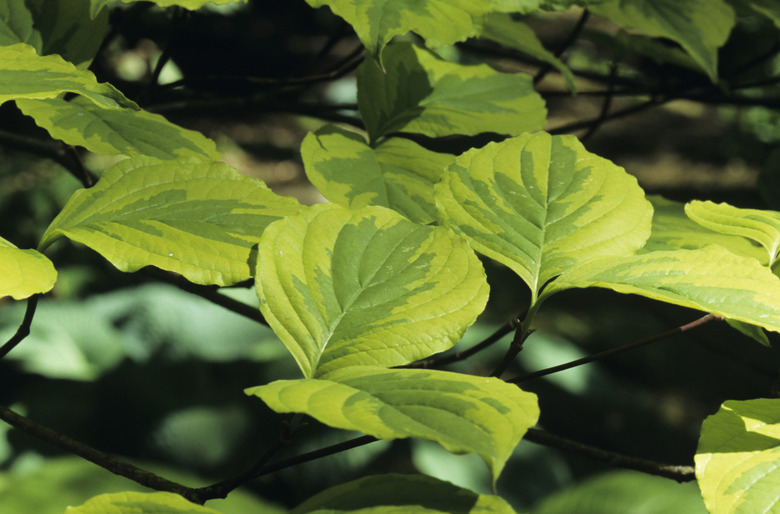The Leaves Are Cupping Up On My Dogwood
Few flowering trees are as endearing and recognizable as the dogwood (Cornus spp.), which thrives in U.S. Department of Agriculture plant hardiness zones 2 through 9. Sporting masses of white, pink or red "flowers," which are actually colorful bracts, the dogwood tree often pays a price for its beauty. Environmental disorders and infectious diseases may cause dogwood's leaves to cup and curl, and can threaten the tree's health wherever it grows.
Leaf Scorch
Step 1
Leaf scorch is most accurately classified as a disorder instead of a disease, and it is not infectious. This disorder causes unsightly distorted and curled leaves that often have brown margins. Among dogwood species, leaf scorch is a common malady that typically attacks trees that are drought-stressed, or wind- or heat-damaged. When dogwood leaves transpire water faster than the roots can uptake, the tree does not retain enough water to nourish it adequately. Although leaf scorch is rarely fatal to a dogwood tree, it may weaken it. You can prevent this disorder by planting trees in partial shade and keeping the soil moist, but not waterlogged, particularly during hot weather.
- Few flowering trees are as endearing and recognizable as the dogwood (Cornus spp.
- ), Environmental disorders and infectious diseases may cause dogwood's leaves to cup and curl, and can threaten the tree's health wherever it grows.
Anthracnose
Step 1
Dogwood trees are susceptible hosts to anthracnose diseases, primarily spot anthracnose, caused by the Elsinoe corni pathogen, and dogwood anthracnose, caused by the Discula destructive pathogen. These diseases are fungi that prosper in cool, wet weather and infect leaves as soon as they open in spring. Leaf spots are the first symptoms of these diseases. Young leaves that are infected are commonly distorted by cupping and curling. Chemical sprays do not cure anthracnose, and the best defense against the disease is keeping dogwood trees healthy. Because anthracnose pathogens overwinter in fallen debris, rake all fallen leaves, and remove dropped twigs and branches after leaf fall in autumn. Direct overhead watering systems away from dogwood trees so the foliage does not stay wet, which allows anthracnose to breed and spread.
- Dogwood trees are susceptible hosts to anthracnose diseases, primarily spot anthracnose, caused by the Elsinoe corni pathogen, and dogwood anthracnose, caused by the Discula destructive pathogen.
- Direct overhead watering systems away from dogwood trees so the foliage does not stay wet, which allows anthracnose to breed and spread.
Powdery Mildew
Step 1
Powdery mildew is a descriptive catchall term for numerous fungal pathogens that leave similar symptoms on plants. On dogwood trees, Mycrosphaeria pulchra is the causal pathogen for powdery mildew. This disease causes a white, powdery coating on upper leaf surfaces. As the disease progresses, the leaves may cup or curl upward. If you see the white coating and cupped leaves on your tree, fungicides cannot cure the disease, which is already established. Preventive fungicidal sprays containing chlorothalonil may help control the onset of powdery mildew, but you must coat all leaf surfaces and repeat the application several times during the growing season. The height of a mature tree and the cost of treating it typically outweigh the benefits. A more attainable goal is to manage the environmental influences that favor the disease. Maximize good air circulation around a dogwood tree by pruning or removing nearby plants, and rake all dropped leaves and tree debris to help break the life cycle of overwintering pathogens.
- Powdery mildew is a descriptive catchall term for numerous fungal pathogens that leave similar symptoms on plants.
- Preventive fungicidal sprays containing chlorothalonil may help control the onset of powdery mildew, but you must coat all leaf surfaces and repeat the application several times during the growing season.
Considerations
Step 1
Other dogwood diseases, such as those caused by Septoria cornicola species pathogens, may also show leaf-spotting symptoms similar to anthracnose, but they do not cause cupped or curled leaves. Generally, white dogwood cultivars are more susceptible to spot anthracnose than pink cultivars. Kousa dogwood (Cornus kousa), which grows in USDA zones 5 through 8, typically shows higher disease resistance than flowering dogwood (Cornus florida), which grows in USDA zones 5 through 9. Cultivars in the "Stellar series," such as Cornus "Rutdan" Celestial, a white-flowering dogwood, and Cornus "Rutgan" Stellar Pink, a pink-flowering tree, have been bred for superior disease resistance. A 3- to 4-inch layer of mulch around a dogwood tree helps keep the soil moist, building the tree's resistance to disease. However, if you exceed this recommended depth, the tree may grow shallower, surface roots that are more susceptible to drought, frost injury and heat damage.
